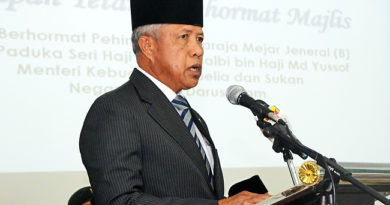HEADLINE: PETALING JAYA, Malaysia- When taps run dry

PETALING JAYA: Malaysians are huge consumers of water. The average person in this country uses 219 litres of water per day. For comparison, the average Singaporean uses just 141 litres, and in Indonesia, it is marginally higher, at 144 litres.
The high consumption, coupled with a rising population, has put more pressure on the country’s water resources.
Back in 1981, the country produced 2,126 MLD (million litres per day) of treated water each day. By 2017, it had risen eight-fold to 16,884 MLD. In that same period, the population had barely doubled.
Records show that almost 60% of the treated water produced each day is used up.

But a rising population is only one of many factors that will continue to beset the country’s water resources.
According to the Association of Water and Energy Research Malaysia (Awer), several other factors must be addressed to ensure a continuous supply that is safe for consumption.
Awer president S. Piarapakaran singled out a low reserve margin, uncontrolled land use and pollution as the issues to tackle to ensure adequate and undisrupted supply.
The average treated water reserve margin in the country was only 11.5%, or 1,943 MLD, as of the second quarter of 2020, Deputy

Environment and Water Minister Datuk Dr Ahmad Masrizal Muhammad said last year.
This is barely 20% of the 10,130 MLD that is consumed each day.
“In the event of unforeseen circumstances, such as pollution or a burst pipe, the taps will quickly run dry,” Piarapakaran pointed out.
This is purely a technical problem, but people in the Klang Valley have had to live with it since 2008.
Piarapakaran said factories and workshops have been operating close to rivers for decades, in defiance of regulations that a buffer zone is essential to protect waterways.
Last but not least, is the lack of pollution control. “Even if we raise our standards to the highest level now, we would still have a large amount of pollutants in our rivers,” he said.
The incidents of waste being discharged into Sungai Kim Kim in 2019 and in Sungai Gong last year that left thousands of people ill are just two examples of the authorities’ failure to put a stop to pollution.
To address these issues, Piarapakaran said stakeholders must ascertain the current state of affairs so that a reliable forecast for future water demands can be made.
Environment and Water Ministry secretary-general Datuk Seri Zaini Ujang believes a two-prong approach is necessary to ensure adequacy in the supply of treated water and the long-term viability of water resources.
“To raise treatment capacity and reserve margin, we have to upgrade or refurbish existing water treatment plants and build new ones. We have to repair old reservoirs and construct new ones as well,” he told theSun.
.

To reduce NRW (non-revenue water or water that is lost through leakage) a national water grid system must be established, he added.
For the long term, Zaini said, there should also be more dams and other facilities to store raw water.
“We should also implement raw water transfer schemes as well as utilise reclaimed water from wastewater plants,” he added.
However, additional infrastructure can only go so far. As the world marked World Water Day on Monday, it became even more obvious that consumers have a key role to play to stem wastage.
Malaysians continue to pay very little for treated water, a leading cause of uncontrolled usage and wastage. For instance, in Penang water costs only 22 sen per 1,000 litres for the first 20,000 litres, the cheapest in the country.
Not surprisingly, Penangites are also the top users, consuming 277 litres each per day, two-and-a-half times the 108 litres consumed each day by the average Sabahan.
At that rate, even a country blessed with abundant rainfall, such as Malaysia, will have no guarantee that the taps will continue to flow.
.











